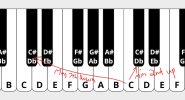mwd
Power User
Many times, when playing pentatonic type scale in A I will bounce from an E note on second string to a D# note on third string then continue in pentatonic mode.
In calculating that interval I feel like the E would be my root or 1st note and the D# the 2nd note based on the way I'm playing it. One site that has a type of relationship calculator says if I calculate it as E to D# it's a major 7th but D# to E would be a minor 2nd.
I don't have enough interval knowledge to know if this is a calculator error or if that is fact based on the direction of travel of the root to 2nd note.
In calculating that interval I feel like the E would be my root or 1st note and the D# the 2nd note based on the way I'm playing it. One site that has a type of relationship calculator says if I calculate it as E to D# it's a major 7th but D# to E would be a minor 2nd.
I don't have enough interval knowledge to know if this is a calculator error or if that is fact based on the direction of travel of the root to 2nd note.


